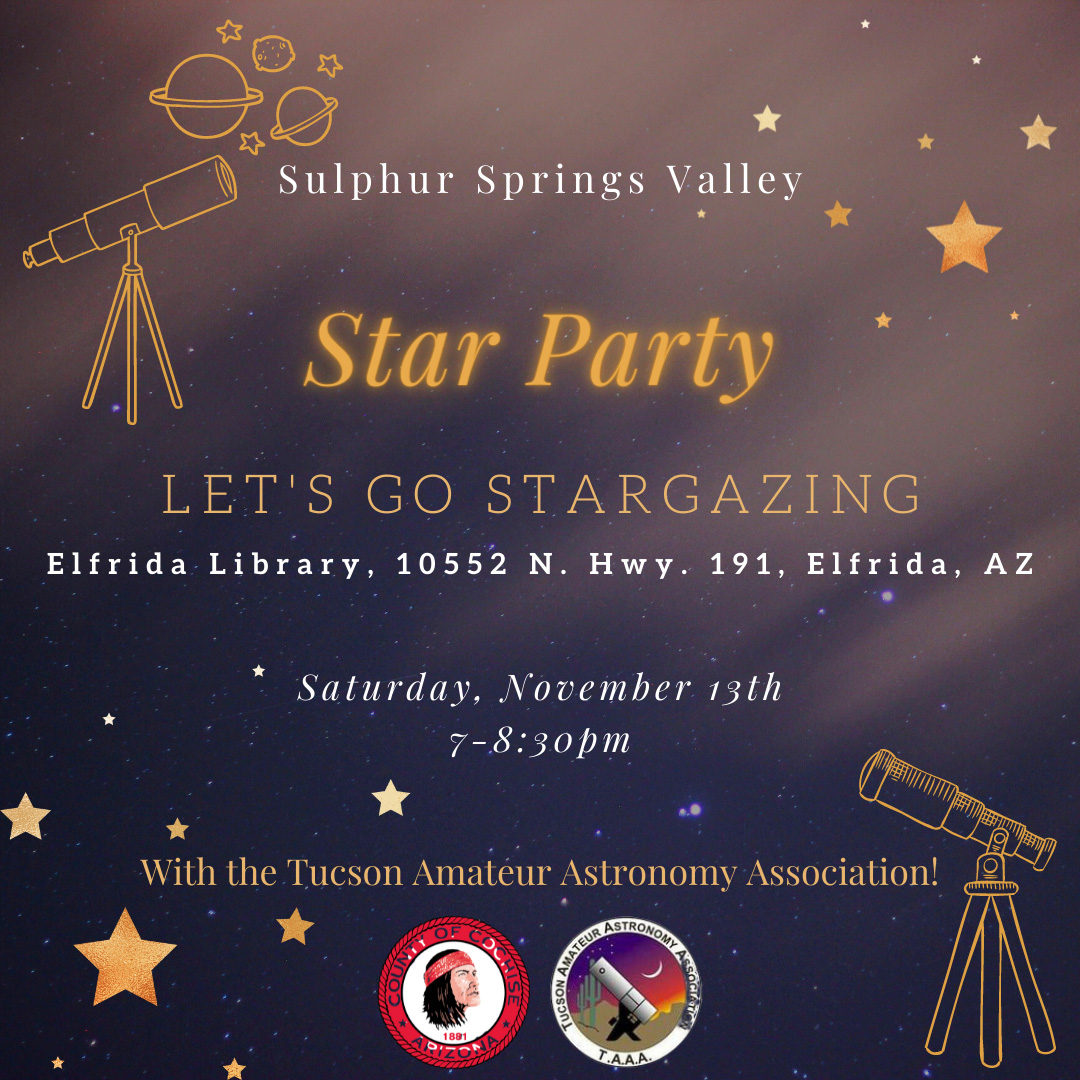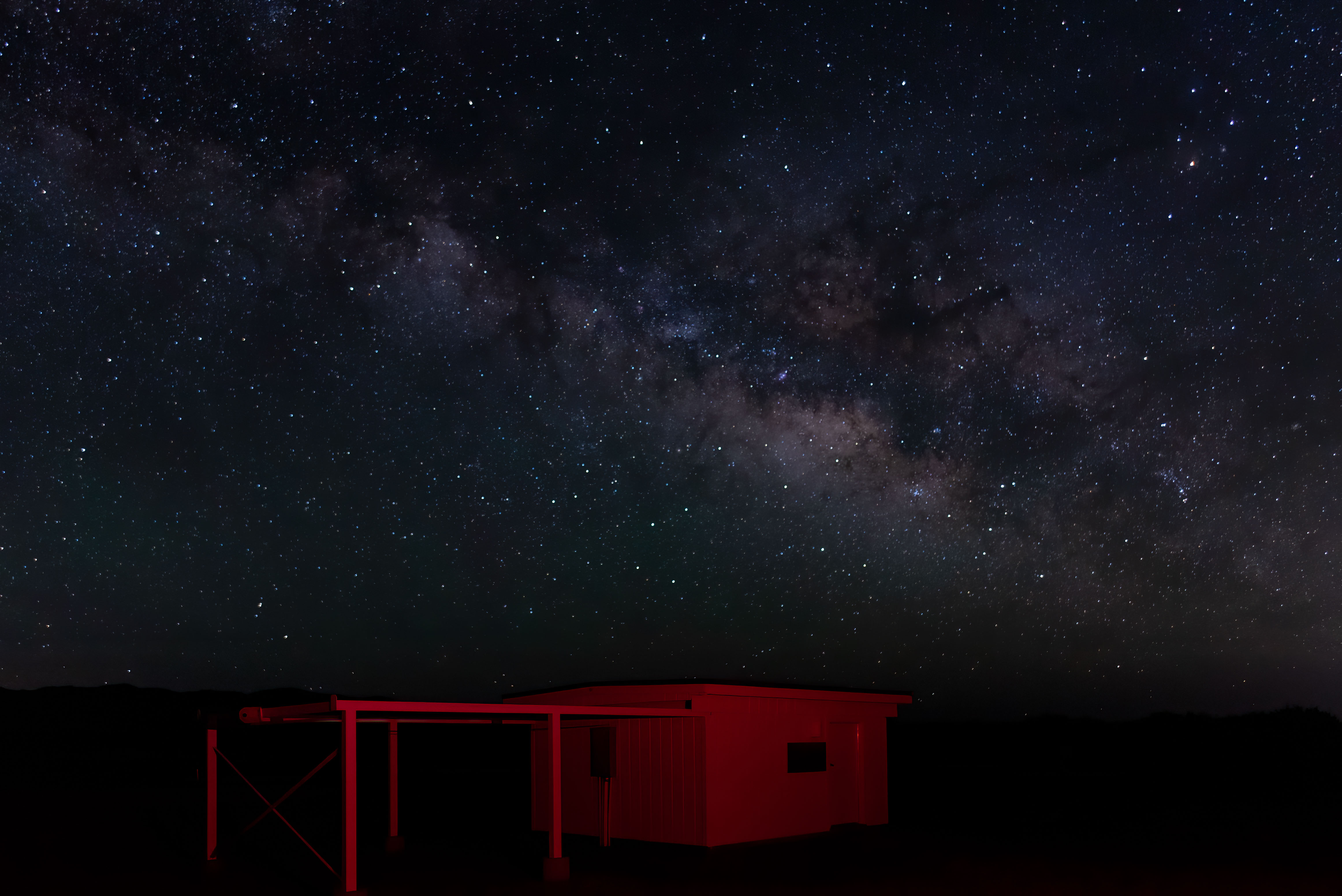 Join TAAA and the Elfrida Library for an evening of stargazing at the Elfrida Library, Elfrida, AZ. We will have a couple TAAA telescopes and the Library will have their tabletop library telescope available for patrons to get familiar with so you can check it out in the future.
Join TAAA and the Elfrida Library for an evening of stargazing at the Elfrida Library, Elfrida, AZ. We will have a couple TAAA telescopes and the Library will have their tabletop library telescope available for patrons to get familiar with so you can check it out in the future.
Empire Ranch Solar
Saturday November 6 and Sunday November 7 — SE TUCSON [SONOITA] (SOLAR (all day)
Empire Ranch Cowboy Festival
Highyway 83 SE of Tucson approximately 20 miles
Age/Grade Level: All Ages
# Participants: 300
Solar Observing throughout the day / Other Festival activities.
Nearest Moon Phase: N/A
Directions: East on I-10 to Highway 83. South on Highway 83 approximately 18 miles to paved road on left between miles post 40 & 39 (watch for brown Historic Empire Ranch sign). East on raod and follow for 3 miles to Empire Ranch House.
Viewing Location: TBD.
Planets of the Month: October, 2021
By Erich Karkoschka

Mercury has its best morning apparition starting on the 17th. During the last week of October it will be easily visible just before 6 am looking east.

Venus is finally becoming a brilliant evening “star”. All month it sets at 8:10 pm. It speeds past Antares on the 16th at 1 1/2 degrees distance. On the 29th, it is in greatest elongation from the sun at 47 degrees. It moves far south and thus sets further south of west than the sun does in December.

The Moon will be a thin crescent at dusk on the 7th. Two days later it will make a beautiful pair with Venus.

Jupiter and Saturn transit halfway up mid evening. They stop their retrograde motion and move prograde again in Capricornus. They reach their closest separation of 15 degrees at the end of the month. The next time they will be that close will be in 2040. Mondays will be the days to look for Ganymede’s shadow on Jupiter’s disk, on the 11th until 7:30 pm, on the 18th from 8-11:30 pm, just after Io’s shadow entered at 11:15 pm, and on the 25th starting just before midnight. A double transit will occur on the 20th until 8 pm with Io’s shadow and Callisto itself.


Uranus and Neptune are up most of the night in Aries and Aquarius, respectively.
Planets of the Month: September 2021
By Erich Karkoschka

Mercury is visible about 15 degrees to the lower right of Venus until September 21st. It is so low that it remains close to the limit of visibility (use extreme caution to avoid looking at the Sun). It passes Spica on the 21st. However, Spica definitely requires binoculars since it is one magnitude fainter than Mercury.

Venus is the obvious evening star until it sets after 8 pm. It passes Spica on the 5th. Venus is slowly brightening towards its best in December.

The two giant gas planets shine in the southeast during dusk. Their distance slowly decreases from 18 degrees at the beginning of September to 15 degrees at the end. They transit around 10 pm, perfect for telescope or binocular viewing.

The Galilean satellites’ orbits are very close to edge-on this month, so that conjunctions of two satellites become very close. The best shadow transit occurs on the 5th starting at 7:45 pm when the dark disk of Ganymede is already close to the center of Jupiter’s disk, so that two dark spots will be visible. The same occurs 7 days later, although Ganymede’s transit does not start until 9:20 pm with its shadow joining at 11:47 pm. Also, on the 17th, Callisto’s shadow can be seen until 8:13 pm.

Neptune comes into opposition in the constellation Pisces on September 14th. Uranus is one constellation further east in Aries.

The Moon might be just barely visible on September 7th (one day past New Moon), 10 degrees to the right of Mercury. Even if Mercury is difficult to spot, you will see it before you see the Moon. The three day old Moon has a beautiful pairing with Venus on September 9th. Three days later it passes Antares.
International Observe the Moon
International Observe the Moon is October 16, 2021. If there are not any specific events scheduled, get out a pair of binoculars or just go out and observe the Moon with your eyes. The Moon will be a Waxing Gibbous, between First Quarter and Full.
We have several telescopes available to check out from the Pima County Library. This is a great use of the telescope, having fun observing the Moon with your family or friends. For more information on our Library Telescope program and how to check one out, visit our webpage at Library Telescope.
VIRTUAL STAR PARTY August 27, 2021
Our next VIRTUAL STAR PARTY is Friday August 27th from 7:30 – 9 pm Tucson, AZ time (PDT). We will stream live solar system and deep-sky viewing to our Facebook Page. Join us at: https://www.facebook.com/TucsonAstronomy
Chiricahua Astronomy Complex Observing
Come join us for an evening of observing at our Chiricahua Astronomy Complex (CAC), 100 miles southeast of Tucson near the Chiricahua Mountains. CAC is an incredibly dark site with several large telescopes. The number of telescopes used will depend on the number of participants. Cost is only $50/adult and $25/child under 15. For reservations and additional information, visit our Tucson Stargazing Adventures or select Star Parties, Tucson Stargazing Adventures, Observing at our very dark site.
Chiricahua Astronomy Complex Observing
 Come join us for an evening of observing at our Chiricahua Astronomy Complex (CAC), 100 miles southeast of Tucson near the Chiricahua Mountains. CAC is an incredibly dark site with several large telescopes. The number of telescopes used will depend on the number of participants. Cost is only $50/adult and $25/child under 15. For reservations and additional information, visit our Tucson Stargazing Adventures or select Star Parties, Tucson Stargazing Adventures, Observing at our very dark site.
Come join us for an evening of observing at our Chiricahua Astronomy Complex (CAC), 100 miles southeast of Tucson near the Chiricahua Mountains. CAC is an incredibly dark site with several large telescopes. The number of telescopes used will depend on the number of participants. Cost is only $50/adult and $25/child under 15. For reservations and additional information, visit our Tucson Stargazing Adventures or select Star Parties, Tucson Stargazing Adventures, Observing at our very dark site.
Chiricahua Astronomy Complex Observing
 Come join us for an evening of observing at our Chiricahua Astronomy Complex (CAC), 100 miles southeast of Tucson near the Chiricahua Mountains. CAC is an incredibly dark site with several large telescopes. The number of telescopes used will depend on the number of participants. Cost is only $50/adult and $25/child under 15. For reservations and additional information, visit our Tucson Stargazing Adventures or select Star Parties, Tucson Stargazing Adventures, Observing at our very dark site.
Come join us for an evening of observing at our Chiricahua Astronomy Complex (CAC), 100 miles southeast of Tucson near the Chiricahua Mountains. CAC is an incredibly dark site with several large telescopes. The number of telescopes used will depend on the number of participants. Cost is only $50/adult and $25/child under 15. For reservations and additional information, visit our Tucson Stargazing Adventures or select Star Parties, Tucson Stargazing Adventures, Observing at our very dark site.
ONLINE – Astronomy Fundamentals Meeting – November 2021
Constellation of the Month:
Libra and Norma
Presenter: Peter Hermes
Peter Hermes will be presenting Libra and Norma for the constellation of the month.
Main Presentation:
None
Presenter:
We do not have a main topic presenter this month.

